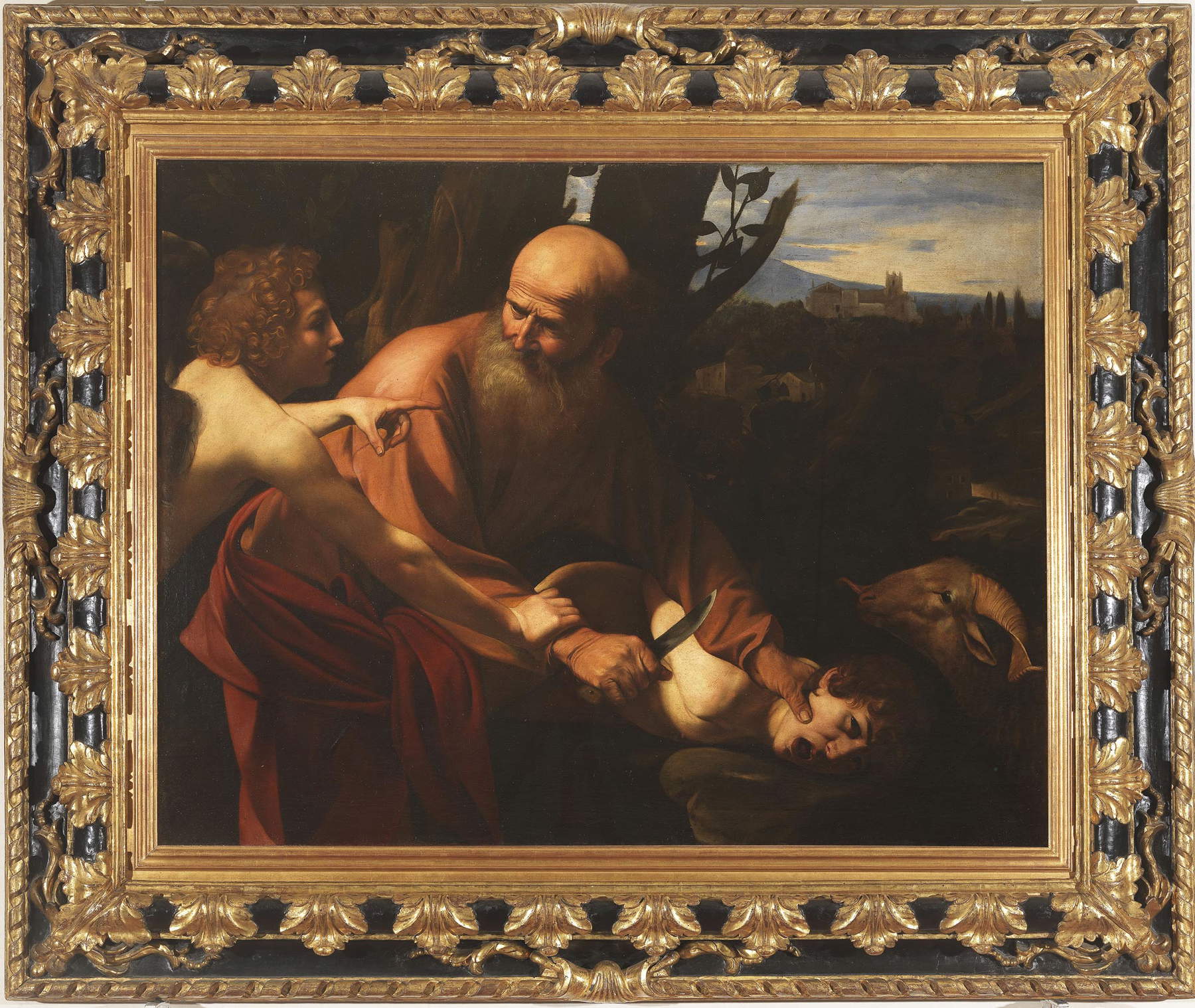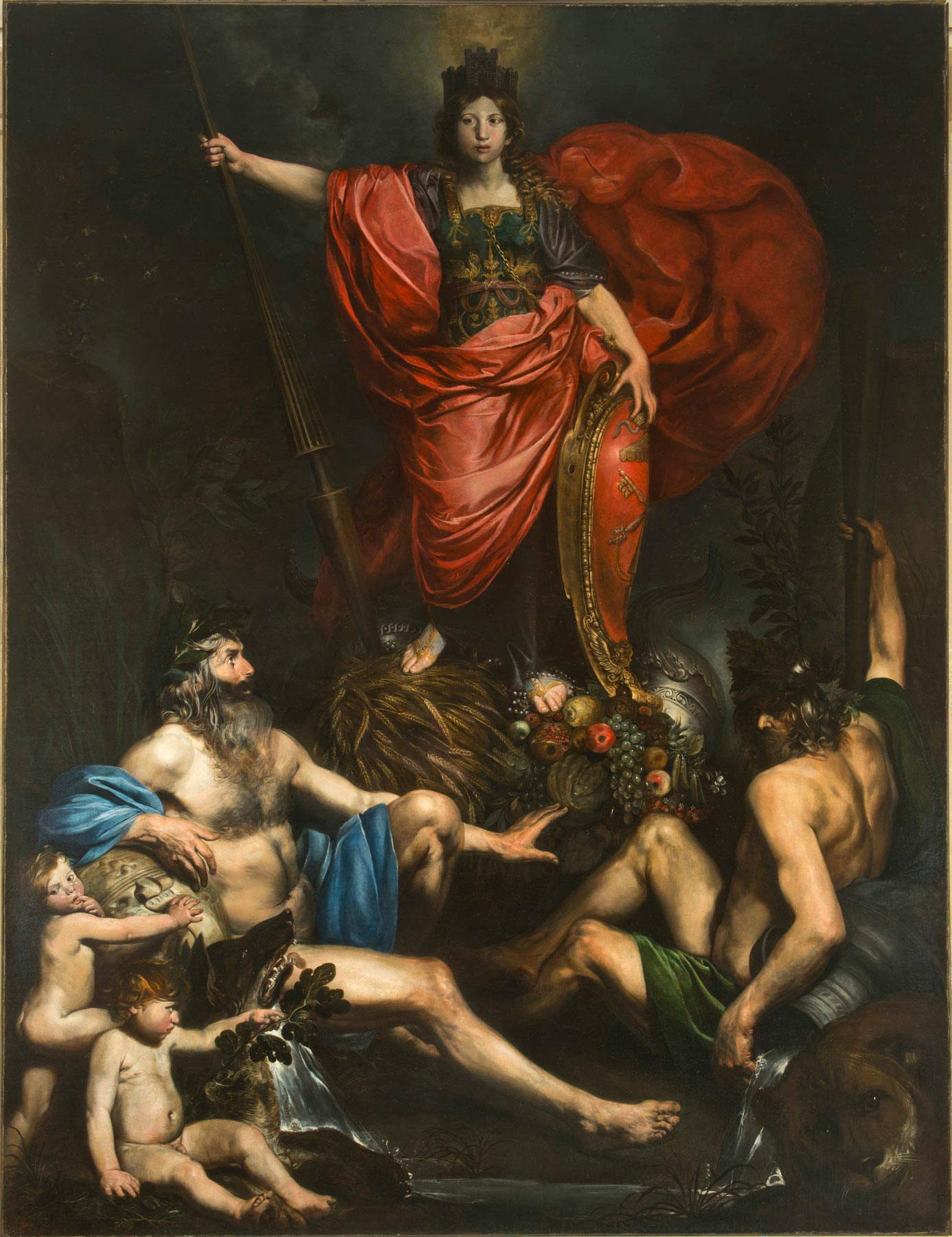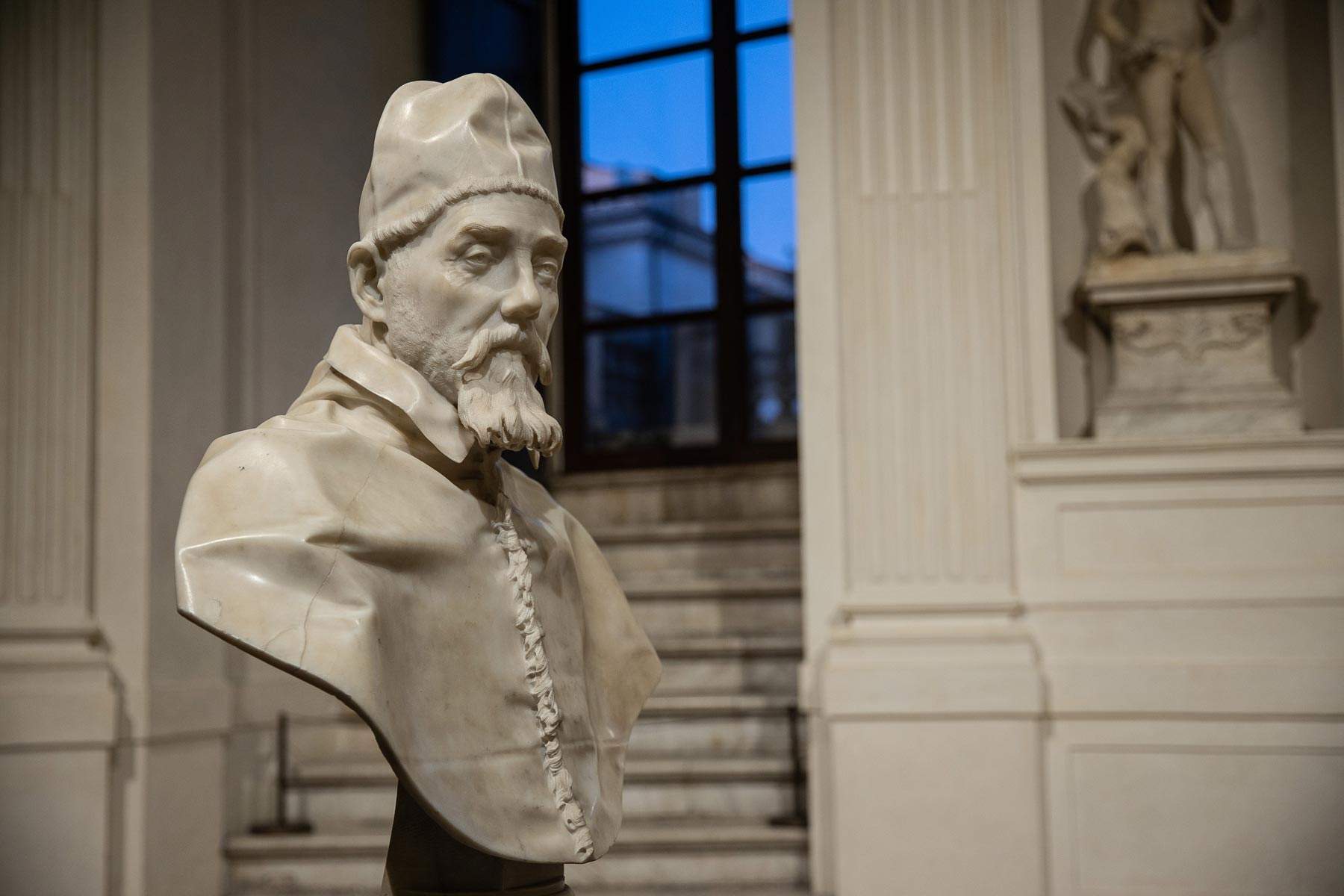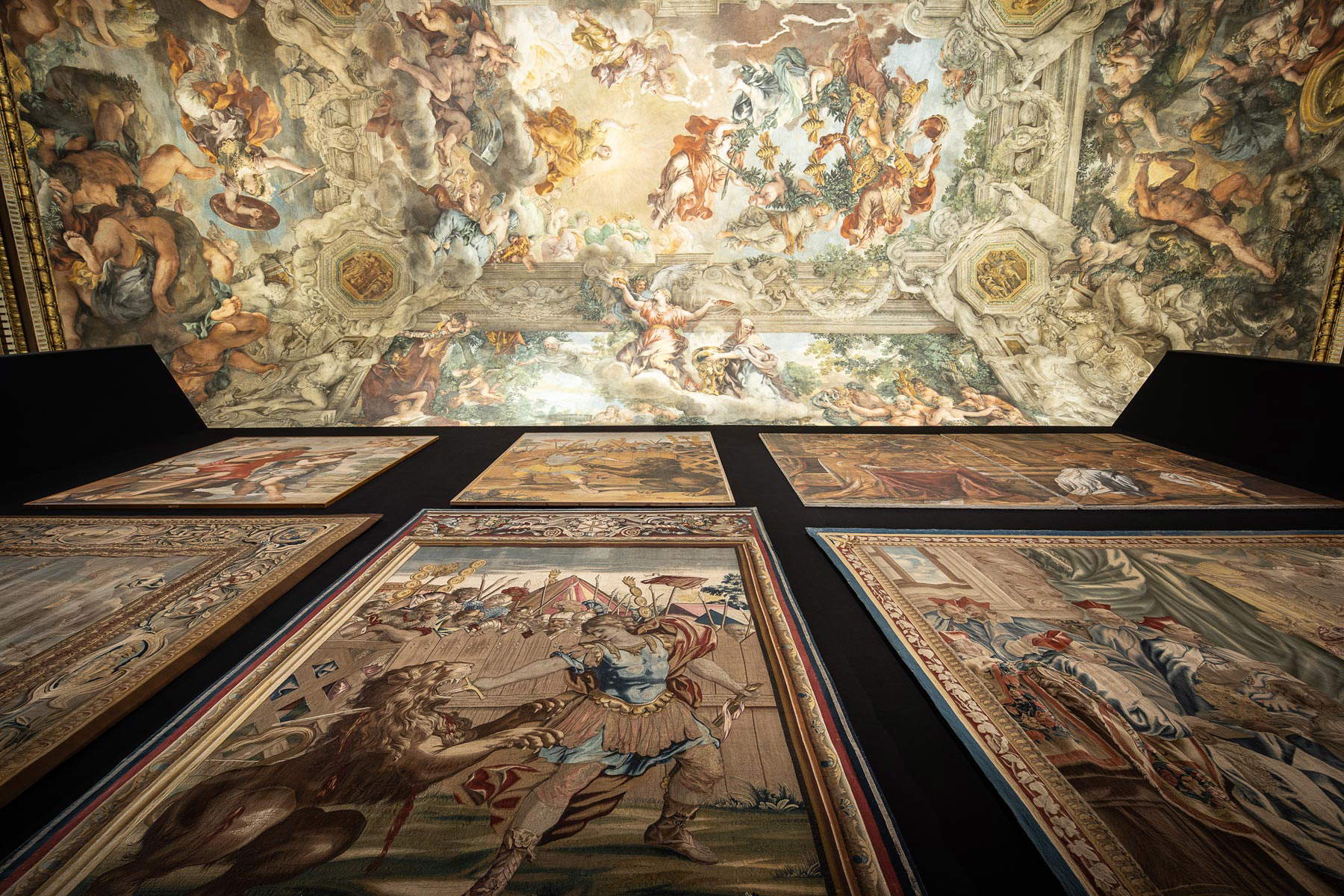On the occasion of the 400th anniversary of the election to the papal throne of Urban VIII Barberini, born Maffeo Barberini, the National Galleries of Ancient Art at Palazzo Barberini in Rome are dedicating, from March 18 to July 30, 2023, a major exhibition to the longest and most representative pontificate of the 17th century (1623-1644).
Curated by Maurizia Cicconi, Flaminia Gennari Santori and Sebastian Schütze, the exhibition, entitled The Sovereign Image. Urban VIII and the Barberini is produced by the National Galleries of Ancient Art with the support of the Directorate General of Museums of the Ministry of Culture. The exhibition reconstructs the cultural and political profile of the pope who more than any other affected philosophical thought, scientific knowledge and the arts in the seventeenth century, with the aim of illustrating the ways through which the pontiff favored the instrument of cultural hegemony as a function of political and governmental action. Urban VIII, together with his nephews, Cardinals Francesco and Antonio and Prince Taddeo Barberini, tenaciously pursued an ambitious political-cultural project that pervaded all areas of knowledge and artistic and cultural production.
For the man of letters and poet Maffeo Barberini , patronage and the promotion of the arts contributed substantially to the strengthening of the spiritual and temporal government of the Church, and not only to the enhancement of personal and family prestige. Urban VIII gave an unmistakable stamp to his pontificate, promoting colossal feats such as the baldachin at St. Peter’s, designed by Gian Lorenzo Bernini, orPietro da Cortona’s fresco in the great hall of Palazzo Barberini. A new style was imposed, which had immediate spread not only in Rome and Italy, but in the entire European scene: the Baroque was in fact born in Rome under the Barberinis.
For the first time, protagonists and masterpieces of that exceptional season that was the pontificate of Urban VIII will be reunited again at Palazzo Barberini, the sumptuous family residence built opposite the Quirinale. Masterpieces from the Barberini collection, dismembered over the centuries and currently conserved in the world’s major museums, thus return to their original home; works by, among others, Gian Lorenzo Bernini, Caravaggio, Valentin de Boulogne, Francesco Mochi, Nicolas Poussin, Andrea Sacchi and some of the spectacular tapestries produced by the Barberini Tapestry Workshop will be on view. On display are more than 80 works from the museum’s collection and from more than 40 museum institutions, private Italian and international collections: from the Uffizi to the Pinacoteca di Brera, from the Galleria Borghese to the National Museum of Capodimonte, from the Vatican Museums to the Capitoline Museums, and then foreign museums, from the Staatliche Museen in Berlin to the British Museum, from the National Gallery in London to the Prado, from the Kunsthistorisches Museum in Vienna to the Louvre, from the Getty in Los Angeles to the Minneapolis Institute of Art, from the Metropolitan in New York to the Saint Louis Art Museum, from the Philadelphia Museum of Art to the Cleveland Museum of Art. Important loans also come from valuable collaboration with important private collections, including that of Prince Corsini of Florence.
In addition to the masterpieces, which were used as a tool of fine international diplomacy at the major European courts, the books, prints, objects, the highly refined antiquarian collection and the great family tapestries will contribute to bring to life, in a once-in-a-lifetime occasion, the protagonists of the period. Indeed, the exhibition aims “to return to the public” the dominant ideas and functioning of an extraordinarily ambitious intellectual project, which transformed Rome into the cradle and radiating place of Baroque culture starting from Palazzo Barberini as its ideal center.
The itinerary is divided into twelve sections, proceeding from the Exhibition Space on the ground floor to the most emblematic spaces of the museum, such as the monumental rooms of the piano nobile: Salone Pietro da Cortona, Marble Room, Throne Room, Landscape Room and some rooms of the permanent collection. Section 1, “Pleasure and Strategy,” focuses on the figure of Maffeo Barberini: on display here are a series of portraits and a number of works documented in his personal collection that testify to his being, even as a cardinal, a refined student of the arts. These include Caravaggio’s Sacrifice of Isaac (Uffizi Galleries); St. Sebastian in the Cloaca Maxima (The J. Paul Getty Museum). Section 2, “Imagining the Dynasty,” presents the other co-protagonists of the papacy, primarily his nephews, Cardinals Francesco and Antonio and Prince Taddeo Barberini, who played a key role in shaping his uncle’s ambitious design. Prominent among the works on display is Gian Lorenzo Bernini’s bronze Portrait of Urban VIII, commissioned by Cardinal Antonio in 1656, more than 10 years after the Pope’s death and on loan from the collection of Prince Corsini, where it arrived in the second half of the 19th century following the marriage of Anna Barberini and Tommaso Corsini. On display in this section will be Andrea Sacchi’s Portrait of Taddeo Barberini, on loan from the Collection of the National Social Security Institute. At the conclusion of the exhibition, the painting will undergo restoration by the museum’s Restoration Laboratory. Section 3, “The Factory of the Saints,” illustrates the central themes of Urban VIII’s governing action, namely the effort to reaffirm the universalism of the Catholic Church through the celebration of symbolic historical figures such as Matilda of Canossa, the policy of canonization processes and the activity of the Institute of Propaganda Fide, the latter functional to the work of evangelization in the non-European continents. Symbolic work of this section the is Martyrdom of St. Erasmus by Nicolas Poussin (Vatican Museums). Section 4, “Hic Domus,” brings together masterpieces from the Barberini collection. Among them are some extraordinary loans: the Lying Pan attributed to Francesco da Sangallo the Younger (Saint Louis Art Museum); Nicolas Poussin’s Death of Germanicus (Minneapolis Institute of Art), one of the French painter’s most famous works commissioned by Cardinal Francis in 1626; and Andrea Sacchi’s Portrait of Marc’Antonio Pasqualini with Apollo and Marsyas, (The Metropolitan Museum of Art). These will be joined from mid-April by Valentin de Boulogne’s extraordinary Allegory of Rome on loan from the Institutum Romanum Finlandiae, Rome.
Section 5, “Family Enterprises,” houses works and art objects, books and prints illustrating the creation of a specific symbolic and allegorical universe dominated by the sun, bees and laurel, introduced by the emblematic Allegory of Peace, a tribute to Cardinal Francesco Barberini by Giovan Battista Muti and Charles Mellin. Section 6, “Ancient Culture,” is devoted to the activities promoted by the Barberinis in the recovery of ancient and late antique art, well documented in their collections. On display is Jean Lemaire’s large canvas, An anchorite with the Barberini obelisk, from the collections of the Prado Museum. Section 7, “Modern Science,” testifies to the fundamental role of the family’s activities in promoting scientific culture, showing how the pursuit of knowledge of an encyclopedic nature and the interweaving of curiosity, science and wisdom, typical of the age of Urban VIII, acquired a wholly peculiar significance in the Barberini’s perspective of self-representation. Emblematic of this section is the famous work by Francisco Hernandez, known as the Mexican Treasure (1649), which reproduces the so-called Barberini Dragon. Representing the extraordinary interest of the great noble families in science will be on display Tlamachayatl (dated 1534) one of the rare examples of Mesoamerican feathered textiles known today, on loan from the Museum of Civilizations in Rome. Section 8, “Weaving the Weft,” is reserved for tapestries made during the 17th century by the Barberini tapestry workshop, an extraordinary business operation promoted in 1625 by Cardinal Francesco Barberini. In the Salone di Pietro da Cortona, tapestries (kept partly in the Vatican Museums and largely in the United States) are juxtaposed for the first time with their preparatory cartoons, mostly belonging to the collection of the National Galleries.
Section 9, “Rhetoric and Poetry,” is dedicated to the relationship of the pope and his nephews with literary institutions, in memory of the academic gatherings held there at the behest of Antonio Barberini. The Oval Room will display Gian Lorenzo Bernini’s Bust of Urban VIII in dialogue with Giuliano Finelli’s Bust of Francesco Bracciolini (Victoria and Albert Museum), while the adjoining Landscape Room will present key texts from the literary and panegyric production of theperiod, including the Poemata written by Maffeo Barberini himself (Biblioteca Apostolica Vaticana) and the Aedes Barberinae (1642) by Girolamo Teti (Biblioteca Casanatense), which celebrate Palazzo Barberini and its masterpieces. Section 10, “Le Api Munifiche,” is devoted to works commissioned by the pope’s nephews and then sent as diplomatic gifts to the courts of Paris, Madrid, London and Vienna. In exceptional cases, artists from the Barberini circle executed, as a special favor of the pope, works directly for Charles I and Enrichetta Maria in England, or for Cardinal Richelieu in France: emblematic is the Bust depicting him, by Gian Lorenzo Bernini, on loan from the Musée du Louvre. Section 11, “Around the Beehive,” is devoted to some episodes of collecting by figures from the Barberini family’s closest entourage, who occupied key roles within the Curia and acted as large-scale multipliers and amplifiers of the papal family’s artistic and cultural choices. On display is Simon Vouet’sAllegory of Intellect, Will and Memory from the Capitoline Museums. Concluding the exhibition is Section 12, “The Theater of Amazements,” which recounts the scenographic dimension of Palazzo Barberini, consistent with the original function of the place, dedicated to theatrical performances. On display are some testimonies of the grandiose “urban” events organized by the family, such as the imposing painting La Giostra del Saracino, entrusted to the direction of the faithful Andrea Sacchi or the scenographic Carousel for the entrance of Christina of Sweden by Pietro Gagliardi (both on loan from the Museum of Rome, Palazzo Braschi). On display in this section are two large paintings by Andrea Camassei (1602 - 1649), one of the greatest and most assiduous interpreters of the family’s patronage strategies: The Massacre of the Niobids and The Rest of Diana. The two canvases have been restored especially for the exhibition. The intervention on La strage dei Niobidi was made possible thanks to the technical sponsorship of CBC Conservazione Beni Culturali Soc. Coop, while Il riposo di Diana benefited from the sponsorship of Teleperformance Italia, in collaboration with theCivita Association.
Accompanying the exhibition is a catalog published by Officina Libraria containing essays by Maurizia Cicconi, Flaminia Gennari Santori, and Sebastian Schütze, curators of the exhibition; texts by Filippo Camerota, Anthony Colantuono, Alessandro Cosma, Michele Di Monte, Irene Fosi, Sergio Guarino, Frederick Hammond, James Harper, Ingo Herklotz, Paola Nicita, Louise Rice, Alesandra Rodolfo, Emilio Russo, Francesco Sorce, and Caterina Volpi; catalog entries by Andrea Bacchi, Paola Baldassarri, Francesca Barberini, Lisa Beaven, Valeria Bellomia, Vittoria Brunetti, Keith Christiansen, Anthony Colantuono, Maurizia Cicconi, Alessandro Cosma, Michele Di Monte, Fabrizio Federici, Camilla Fiore, Jeffrey Fraiman, Elisabetta Frulli, Davide Gasparotto, Sergio Guarino, James Harper, Judith Mann, Stefano Papetti, Louise Rice, Alesandra Rodolfo, Sebastian Schütze, Francesco Sorce, Sandra Suatoni, Rossella Vodret, Vitale Zanchettin.
“This exhibition represents the culmination of many years of research work, marking an important milestone in the path of comparison and exchange with Italian and foreign museum institutions that I have pursued since I took office,” says Flaminia Gennari Santori, director of the museum and co-curator of the exhibition. “In fact, there are many museums, collectors and institutions with whom we have woven relationships in recent years, who have understood the importance of the project and enthusiastically adhered by granting prestigious loans.”
The exhibition opens Tuesday through Sunday from 10 a.m. to 7 p.m. (last admission at 6 p.m.). The ticket is valid for 20 days from the time it is stamped for one admission to each of the Museum’s venues: Palazzo Barberini and Galleria Corsini. Ticket cost: Full 15 € - Reduced 2 € (18-25 year olds). Free: under 18 years of age, schoolchildren and accompanying teachers from the European Union (with prior reservation), students and teachers of Architecture, Letters (archaeological or historical-artistic address), Conservation of Cultural Heritage and Educational Sciences, Academies of Fine Arts, employees of the Ministry of Culture, ICOM members, tourist guides and interpreters on duty, journalists with a membership card, disabled persons with accompanying person, school teaching staff, tenured or with a fixed-term contract, upon presentation of appropriate attestation on the model prepared by Miur.
















 |
| Rome, a major exhibition on Urban VIII and the Barberini family at Palazzo Barberini |
Warning: the translation into English of the original Italian article was created using automatic tools. We undertake to review all articles, but we do not guarantee the total absence of inaccuracies in the translation due to the program. You can find the original by clicking on the ITA button. If you find any mistake,please contact us.